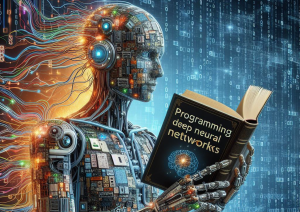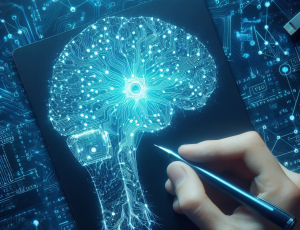deep neural networks
Deep neural networks, or so-called deep neural networks, are one of the top technologies in the field of machine learning and artificial intelligence. These networks model and recognize complex patterns in large and diverse data and are used in various fields such as image recognition, natural language processing, information retrieval, self-driving, and many other issues. In this article, we introduce and explain the principles of deep neural networks.
Meaning and concept
Deep Neural Networks are a type of mathematical models in the field of machine learning and artificial intelligence, whose structure and function are inspired by the way the human brain works. These networks are composed of multiple layers and use similar approaches to recognize patterns and complex features in input data such as images, texts, numerical data, speech, etc.
The formation of a deep neural network mainly consists of two main elements:
-
Hidden Layers: These layers are responsible for extracting and converting input data. Each hidden layer consists of a number of neurons (or processing units) and extract more complex feature information from the input data. These layers are activated by non-linear functions (activation functions) such as ReLU (Rectified Linear Unit).
-
Weights and parameters: Each connection between neurons has a weight. These weights are randomly initialized and then updated by optimization algorithms such as backpropagation. Neural network parameters include these weights and other values such as biases.
The operation of deep neural networks is that at first the input information is processed through hidden layers and different features are extracted from the input data. These features are obtained gradually and deeper from layer to layer. Then, these features are processed by the output layers to produce the final result.
Deep neural networks have high power in learning data representation and the ability to embed patterns and complex features. This allows the network to perform extremely well in various problems such as image recognition, machine translation, natural language processing, and other complex problems. For example, in image recognition, a deep neural network can automatically recognize many image features such as edges, faces, and objects.
Overall, deep neural networks have been heavily processed as one of the first options in solving complex data-driven and machine learning problems in recent decades, and have provided performance improvements in a wide variety of applications and industries.

Neural structure of deep networks
A deep neural network usually consists of several different layers. These layers include:
-
Input Layer: This layer receives input information from various sources such as images, texts or numerical data.
-
Hidden Layers: These layers extract latent and hidden features from the input data. Also, the network learns the parameters of the model by performing mathematical calculations in these layers.
-
Output Layer: This layer produces the final result of the model. Usually, in different problems, the output layer type is different. For example, in image classification problems, an output layer of different classes is used.
Learning in deep neural networks
In learning operations in deep neural networks, iterative steps and matching the model to the input data are very important. These steps generally include the following:
-
Initialization of weights: Initially, the weights are initialized randomly. These weights represent the influence of each connection between neurons.
-
Calculate the output of the model: As training data enters the network, the information is processed from layer to layer and the outputs predicted by the model are produced.
-
Error calculation: The outputs produced by the model are compared with the expected outputs to calculate the difference (error) between them. This error is usually calculated using different loss functions.
-
Backpropagation: This is a fundamental process in learning deep models. In this process, the error is transferred from the output layers to the input layers and the weights are updated. This optimization allows the network to better adapt to the input data and reduce the error.
-
Update weights: Using optimization algorithms such as Gradient Descent and its more advanced versions, the weights and parameters of the network are updated to reduce the error and improve the performance of the model in future predictions.
-
Repeat steps 2 to 5: These steps are executed iteratively so that the model reaches an optimal and desirable performance in predicting new data.
The main goal of this learning process is to improve the performance of the model in predicting new data and to better adapt to the diversity and complexity of the input data. By repeating the learning steps, the neural network gradually acquires more capabilities in extracting and displaying more complex features from the input data and, as a result, performs more accurately in prediction.
Types of deep neural networks
Deep neural networks can be designed in different ways. Some of the most famous types are:
-
Convolutional neural networks (CNN): They are used for image recognition and imaging.
-
Recurrent Neural Networks (RNN): They are used to process sequence data such as texts and speech.
-
Recurrent neural networks (LSTM و GRU): are a type of RNN used to model sequence data with the ability to retain past information.
Transfer neural networks (Transformer Networks): These types of neural networks are usually used for text processing and machine translation. They use attentional mechanisms to integrate information and translate it into different languages.
- Transfer learning transformation networks (Transfer Learning): These types of networks use models trained on large data and then adjust these models for other similar problems. This function is known as transfer learning and helps to improve the performance of models in different problems.

Applications of deep neural networks
Deep neural networks are used in a variety of problems, including:
-
Image recognition: For detecting objects, medical images, face detection, detecting objects in cars, etc.
-
Natural Language Processing: For machine translation, text analysis, automatic question and answer and chatbot systems.
-
Audio processing: For speech-to-text, speech recognition, and keyword recognition systems.
-
Engineering applications: For example, predicting defects in manufactured products, quality control, predicting machine breakdowns, etc.
-
Video games: To produce realistic graphics and artificial intelligence in games.
-
medical: To diagnose diseases from medical images, predict the evolution of diseases, and analyze medical data.
Challenges and related issues
Using deep neural networks in reality is a complex and challenging process and requires expert knowledge. Below are some of the main challenges in using this technology:
-
The need for big data:Deep neural networks require a large amount of training data to achieve better performance. This usually requires large and expensive datasets. Also, all data must be properly labeled, which can be time-consuming and costly.
-
Difficulty interpreting parameters: Deep neural networks usually have millions of parameters and the semantic interpretation of each of these parameters is very difficult. This issue leads to problems of implicit interpretation of models and increasing confidence in their results.
-
Complex cost functions: Choosing the right cost functions for neural network training is important and may require tuning. Determining the appropriate cost function usually requires experience and trial and error.
-
Difficult educational issues: Issues related to network congestion (Overfitting), insufficient training (Underfitting) and training speed can become important challenges in using neural networks. Optimizing these issues requires expert experience and knowledge.
-
Moral issues: The use of deep neural networks can lead to various ethical issues, including the clarification of privacy and privacy issues, fairness in the use of machine learning models, and social and cultural impacts. Examples of ethical issues in the field of machine learning include explaining concerns about models’ compliance with human culture and values or explaining compliance with animal rights.
-
security issues: Deep neural networks may be vulnerable to attacks and security vulnerabilities. Issues related to the security of models and their protection require more attention and research.
In general, the use of deep neural networks by experts and attention to the challenges raised can contribute to sustainable development and effectiveness in the field of machine learning and artificial intelligence.
summary
Deep neural networks are a very powerful technology in the field of machine learning and artificial intelligence. These networks help to recognize patterns and complex features in large and diverse data and are used in various problems from image recognition to natural language processing. With the increasing availability of more computational capabilities and the development of optimization methods, it is expected that the importance and application of deep neural networks will continue to increase in the future.
